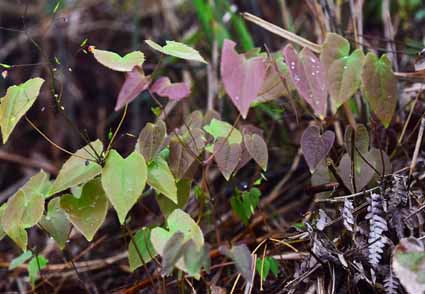Abstract
Epimedium daiguii C. Zhang, B.L. Guo & Q.R. Liu, a new species of the Epimedium, is found and described from Wuling Mountains, Hunan Province, China. It should be a member of Epimedium sect. Diphyllon ser. Brachycerae due to the distinct minor flower feature. This new species resembles E. elachyphyllum (E. parvifolium) in flower traits. The stout rhizomes, flowering stem with two opposite trifoliolate leaves and paniculate inflorescences of this new species distinguish from E. elachyphyllum with elongated rhizomes, flowering stem with a single leaflet, and simple inflorescences.
References
- Avent, T. (2010) An overview of Epimedium. Plantsman 9: 10–17. [Royal Horticultural Society, London]
- Gao, S.G., Cheng L, Li, K.H., Liu, W.H., Xu, M., Jiang, W., Wei, L.C., Zhang, F.J., Xiao, W.F. & Xiong, Y.L. (2012) Effect of epimedium pubescen flavonoid on bone mineral status and bone turnover in male rats chronically exposed to cigarette smoke. BMC Musculoskeletal Disorders 13: 1–10. https://doi.org/10.1186/1471-2474-13-105
- Guo, B.L. & Xiao, P.G. (1999) The flavonoids in Epimedium L. and their taxonomic significance. Journal of Systematics and Evolution 37: 228. [https://www.jse.ac.cn/EN/Y1999/V37/I3/228]
- He, S.Z., Wang, Y.Y., Guo, B.L. & Xu, W.F. (2010) Epimedium pudingense (Berberidaceae), a new species from Guizhou, China. Annales Botanici Fennici 47: 226–228. https://doi.org/10.5735/085.047.0308
- IUCN (2001) IUCN red list of threatened species, version 3.1. IUCN Red List Unit, Cambridge U.K. Available from: http://www. iucnredlist.org/ (accessed 31 October 2016)
- Li, H.F., Guan, X.Y., Yang, W.Z., Ye, M., Sun, C., Lu, S. & Guo, D.A. (2012) Antioxidant flavonoids from Epimedium wushanense. Fitoterapia 83: 44–48. https://doi.org/10.1016/j.fitote.2011.09.010
- Linnaeus, C. (1753) Species Plantarum 1. Laurentii Salvii, Holmiae, 1200 pp.
- Lubell, J.D. & Brand, M.H. (2005) Division size and timing influence propagation of four species of Epimedium L. HortScience 40: 1444–1447. https://doi.org/10.21273/HORTSCI.40.5.1444
- Ma, H.P., He, X.R., Yang, Y., Li, M.X., Hao, D.J. & Jia, Z.P. (2011) The genus Epimedium: an ethnopharmacological and phytochemical review. Journal of Ethnopharmacology 134: 519–541. https://doi.org/10.1016/j.jep.2011.01.001
- Morren, C. (1834) Plantations d’agrément. L’horticulteur belge, journal des jardiniers et amateurs 2: 141.
- Ren, L., Dai, S.L. & Wang, Y. (2008) The germplasm resources of Epimedium in China and its application in landscape architecture. Journal of Wuhan Botanical Research 26: 644–649.
- Sally, G. (2015) The plant lover’s guide to Epimediums. Timber press, London, 240 pp.
- Stearn, W.T. (1938) Epimedium and Vancouveria (Berberidaceae), a monograph. Botanical Journal of the Linnean Society 51: 500. https://doi.org/10.1111/j.1095-8339.1937.tb01914.x
- Stearn, W.T. (2002) The Genus Epimedium and other Herbaceous Berberidaceae including the Genus Podophyllum. Timber Press, Oregon, 199 pp.
- Sun, Y., Fung, K.P., Leung, P.C. & Shaw, P.C. (2005) A phylogenetic analysis of Epimedium (Berberidaceae) based on nuclear ribosomal DNA sequences. Molecular Phylogenetics and Evolution 35: 287–291. https://doi.org/10.1016/j.ympev.2004.12.014
- Wang, Y.Y., Xu, W.F. & He, S.Z. (2017) Epimedium muhuangense (Berberidaceae), a new species from China. Phytotaxa 319: 277–282. https://doi.org/10.11646/phytotaxa.319.3.7
- Xia, G.H. & Li, G.Y. (2009) Epimedium jingzhouense sp. nov. (Berberidaceae) from Hunan, China. Nordic Journal of Botany 27: 472–474. https://doi.org/10.1111/j.1756-1051.2009.00532.x
- Xie, J. & Sun, W. (2006) Progress of chemical materials and pharmacy of genus Epimedium plants. Strait Pharmaceutical Journal 18: 17–20.
- Yin, L.L., Lin, L.L., Zhang, L. & Li, L. (2012) Epimedium flavonoids ameliorate experimental autoimmune encephalomyelitis in rats by modulating neuroinflammatory and neurotrophic responses. Neuropharmacology 63: 851–862. https://doi.org/10.1016/j.neuropharm.2012.06.025
- Ying, T.S. (2002) Petal evolution and distribution patterns of Epimedium Linn. (Berberidaceae). Journal of Systematics and Evolution 40: 481. [https://www.jse.ac.cn/CN/Y2002/V40/I6/481]
- Ying, T.S., Boufford, D.E. & Brach, A.R.I. (2011) Epimedium L. In: Wu, Z.Y., Peter, H.R. & Hong, D.Y. (Eds.) Flora of China. Science Press, Beijing & Missouri Botanical Garden Press, St. Louis, pp. 787–799.
- Zhang, C. (2023) Taxonomic studies of Epimedium L. sect. diphyllon (Kom.) Stearn (Berberidaceae). Doctoral Thesis. Beijing Normal University, Beijing, pp. 70–129.
- Zhang, D.G., Deng, T., King, C.K., Zhang, J.W., Nie, Z.L. & Sun, H. (2015) Epimedium tianmenshanensis (Berberidaceae), a new species from central China. Phytotaxa 222: 33–43. https://doi.org/10.11646/phytotaxa.222.1.3
- Zhang, M.L., Uhink, C.H. & Kadereit, J.W. (2007) Phylogeny and biogeography of Epimedium/Vancouveria (Berberidaceae): Western North American–East Asian disjunctions, the origin of European mountain plant taxa, and East Asian species diversity. Systematic Botany 32: 81–92. https://doi.org/10.1600/036364407780360265
- Zhang, Y.J, Li, J.Q., Wang, Y. & Liang, Q. (2021) Taxonomy of Epimedium (Berberidaceae) with special reference to chinese species. Chinese Herbal Medicines 14: 20–35. https://doi.org/10.1016/j.chmed.2021.12.001
- Zhang, Y.J., Yang, L.L., Chen, J.J., Sun, W. & Wang, Y. (2014) Taxonomic and phylogenetic analysis of Epimedium L. based on amplified fragment length polymorphisms. Scientia Horticulturae 170: 284–292. https://doi.org/10.1016/j.scienta.2014.02.025
- Zhang, Y.J., Zhang, S.J., Dang, H.S., Zheng, B., Li, J.Q. & Wang, Y. (2016) Epimedium xichangense (Berberidaceae), a new species from Sichuan, China. Phytotaxa 263: 286–290. https://doi.org/10.11646/phytotaxa.263.3.9


